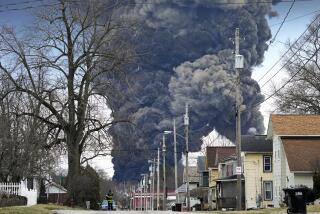Guessed at Weight of Train That Derailed, Clerk Says
- Share via
SAN BERNARDINO — A Southern Pacific clerk said Tuesday that he simply guessed at the weight of a freight train that later proved too heavy for its crew to stop before it careened off the tracks at the foot of the Cajon Pass grade, flattening a row of homes and killing four people.
Testifying in the second day of a hearing before the National Transportation Safety Board, clerk Thomas Blair said he estimated the weight “based on my experience” of 17 years with the railroad.
Conceding that he had committed an “oversight,” Blair said he relied solely on his judgment to determine the weight of the train, having failed to obtain that information from the shipper.
Investigators say the clerk--whose figures were passed on to crew members and were not double-checked--underestimated the weight by one-third. The actual weight of the train--almost 9,000 tons--was nearly 3,000 tons greater than the engineer believed and was probably too heavy for the train’s brakes to handle on the steep hill, computer simulations have shown.
The May 12 derailment and a related gas pipeline explosion two weeks later killed six people, injured 31 and destroyed 17 homes in a poor section of San Bernardino. Investigators believe the underground pipe, which parallels the railroad tracks, probably ruptured and caught fire either because of damage from train wreckage or in cleanup operations later.
Focus of Inquiry
From the start, the safety board’s attempt to determine the cause of the derailment has focused on the weight of the train, which reached speeds in excess of 105 m.p.h. during its 23-mile descent. The freight was traveling from Mojave to the Port of Los Angeles with a load of trona, an ashy mineral that had been mined from Owens Lake.
The weight of a cargo is critical--particularly in mountainous territory--because it determines the number of locomotives needed to power and brake a train and influences the speed at which an engineer travels.
On Tuesday, a representative of the shipper, Lake Minerals Corp. of Lone Pine, Calif., said the company’s contract with Southern Pacific called for the railroad to carry 100 tons of trona per hopper car. Supt. William McClung said he was confident that that was the amount actually placed in the cars because they were loaded with machines equipped with weighing devices.
McClung, however, said he did not supply the 100-ton figure to the rail clerks at Mojave, where the crew picked up the train, because it was not requested. Instead, he left the weight blank on the bill of lading provided to the railroad.
Blair, who has worked for Southern Pacific since 1972, testified that he was unaware of the contract and the 100-ton figure. He said he reviewed the bill of lading with McClung in the clerk’s office in Mojave and that “everything looked OK.” It was only after McClung left, Blair said, that he noticed the weight was missing.
Making an Estimate
Because there is no scale at Mojave--the closest one is in Colton--Blair decided to make an estimate. The figure he entered was 60 tons per car.
“It was an estimate based on my experience working for the railroad,” said Blair, who conceded he was unfamiliar with trona. “I thought about it and I knew that these cars were lighter than cement cars, which weigh 75 tons, so I came up with (60 tons) and entered that.”
Blair said he contemplated telephoning McClung to verify his guess and even called directory assistance to find a number for Lake Minerals Corp. Although the company’s telephone is listed, Blair said he “was unsuccessful.”
Asked by safety board investigators whether he considered holding the train in Mojave until he could confirm the weight, Blair said, “As far as I was concerned, everything was correct and there was no reason” to wait.
Although Blair said he had never before received a bill of lading that lacked a weight, he did not consider consulting supervisors because he believed his figures were “true and good” and knew McClung was “anxious to get this shipment moved.” He added that clerks routinely estimate weights for preliminary purposes but that those figures are always overridden later by figures provided by shippers.
Investigators also queried Blair about his training--it was all “on the job” and provided by senior clerks--and the availability of a company manual listing various commodities and their weights. “There may be a commodity book in (the Mojave office) but we never use it,” Blair told the board.
On Monday, the runaway train’s engineer testified that he made speed calculations and braking decisions based on the erroneous weight. Frank Holland also said he would never have left Mojave without additional locomotives--and thus, the additional braking power the engines provide through a mechanism akin to downshifting a car--had he known the cargo’s true weight.
Also testifying Tuesday was John Puffer, manager of clerical operations for Southern Pacific. Puffer said that since the derailment, the railroad has altered its procedures to guard against the use of estimates by its clerks.
Now, if a shipper’s bill of lading lacks a weight, a Southern Pacific computer generating paper work for a train automatically assumes the weight is the maximum capacity of a given rail car.
“This gives us a margin for error. It was done for safety considerations,” T. H. Hollingshead, Southern Pacific’s general road foreman of engines, said during a break in the hearing.
Nonetheless, Puffer testified that the new rule does not guarantee that there will never be a repeat of the circumstances leading up to the deadly derailment, which left two trainmen and two children dead.
“It could still occur due to human factors,” Puffer said.
More to Read
Sign up for Essential California
The most important California stories and recommendations in your inbox every morning.
You may occasionally receive promotional content from the Los Angeles Times.










